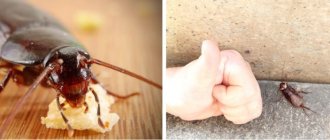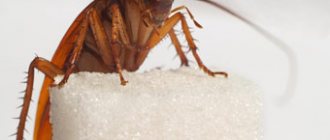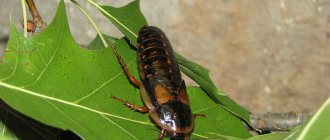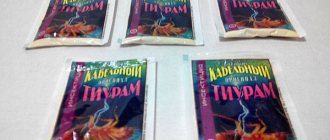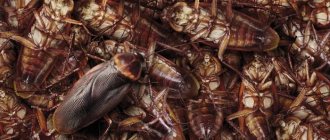The high fertility of cockroaches is one of the main reasons for their high survival rate. A distinctive feature of the species is that a female can mate with a male only once, and then produce offspring several times during her life. At the same time, cockroach eggs are more difficult to destroy than adult ones. They are protected by the ootheca, a membrane that is resistant to chemicals and other external factors. The death of all insects does not guarantee complete ridding of the house from parasites. If among them there were females with ooteca, then a few days after treatment of the room, nymphs may hatch from them. One solution to the problem is to re-apply the insecticide after 10-14 days. In the article, we will look at the difference between an egg and an egg, how many embryos one female produces in a lifetime, and also how to rid your home of annoying parasites.
Reproduction of cockroaches
A female cockroach only needs one mating, and throughout her life she lays fertilized eggs. An ootheca, a capsule containing eggs, is formed in her body.
Emergence of larvae from the ooteca.
The rate at which larvae hatch depends on several factors:
- the type of cockroaches themselves;
- ambient temperature;
- humidity level.
Where do females hide their eggs?
In order to effectively combat pests, a person should know where, most likely, the female will leave her clutch. She mainly chooses secluded, inaccessible places where her offspring will not be disturbed.
These are:
- Gaps between furniture.
- The space under the bedside tables.
- Along or behind baseboards.
- In the ventilation ducts.
- On shelves in the pantry.
- Under the sink.
Knowing the location of the eggs, you can better fight cockroaches. If even a hint of unwanted guests appears, it is worth taking measures to eliminate them. Fortunately, at the moment there are quite a lot of different ways to destroy this type of insect.
And this is what the process of “birthing” cockroaches into the world looks like:
Cockroach larvae are the most dangerous part of the entire population of cockroaches in an apartment for people.
Firstly, there are the most of them here and they are the ones who bring the largest amount of various contaminants into the room and onto food products in the room from sewers, garbage chutes, entrances and other less clean places in the house.
Secondly, it is the larvae of domestic cockroaches that are the source of strong allergens, due to which, perhaps, some of the people living in the house constantly have a stuffy nose and develop chronic allergic rhinitis. Young children are especially sensitive to these allergens - a significant part of children's runny noses, which are not accompanied by an increase in temperature, are caused by cockroach nymphs.
What kind of allergens are these and why are cockroach larvae more dangerous as carriers of allergens than adults?
What is ootheca
Ootheca of the cockroach.
This capsule is sealed, cocoon-like and acts as an incubator. It is a way of protecting offspring and a source of nutrition. The embryos mature in favorable conditions for up to two months. The eggs mature there first, but larvae can also grow immediately.
Most often, the shape of the oviposition is straight, slightly elongated. But there are round or even comma-shaped curved oothecae. They are small in size and very difficult to notice.
The eggs inside can be laid out in one or more rows. Their exact number depends on the type of parasite.
Formation of new masonry
A cockroach can mate with a male only once during its entire life. She stores the resulting seed material and uses it for the rest of her life. The female lives from 5 to 7.5 months. Then she continues the process of reproduction on her own and is able to produce offspring 4 – 9 times. The eggs are formed in the abdomen, which also receives the “building material”: a sticky secretion. As the clutch forms, the ootheca grows in size and “extends” more and more beyond the female’s abdomen. Ultimately, the cockroach looks as if a short shiny yellow-brown block with rounded edges was stuck into the rear tip of the insect's abdomen.
Further, some differences are observed in oviparous species. Black cockroaches get rid of their burden immediately after the formation of a full clutch. For another two months, their offspring mature, being completely defenseless.
Reproduction
Interesting!
Prussians take advantage of this circumstance and eat eggs and newly hatched larvae.
The Prussians themselves behave differently. They have a better developed maternal instinct. The female cockroach runs around with the eggs until the clutch matures. The larvae hatch 30–80 days after the final formation of the capsule.
The rate of development of a new generation of insects depends on the ambient temperature. But the Prussians are also distinguished by a high reproduction rate. Their larval maturation time is 14 – 35 days. The optimal temperature for the development of larvae is +30°C. Air humidity is also important. Dry food is contraindicated for cockroaches.
Cockroach eggs
Eggs in the ooteca.
Cockroach eggs are white or yellowish-white, 1 mm in diameter, densely packed in the ootheca in one or several rows. One such capsule contains up to 50 eggs; during her life, the female is capable of laying up to 8 oothecae. But large species, such as sewers, lay up to 20 times per life cycle. The shell of this capsule protects the offspring from external factors and is resistant to chemicals.
Some types of cockroaches deposit ootheca in hard-to-reach places, thus protecting them not only from people, but also from hungry members of their kind.
Features of the appearance of larvae
While in the ooteca, the embryos develop and grow. At a certain point, the larva becomes cramped in the egg, it gnaws through the wall and crawls out. For the first few days, hatched cockroaches remain in place and feed on the remains of the ootheca (if there is no more attractive food nearby). At first the nymph has a soft shell, but over time the chitinous cover gains strength.
After the first molt, the nymphs become more active, begin to settle in, and look for food. With each subsequent molt (most often there are 6 of them), the larvae grow and acquire the features of adult insects. They develop wings, and later reproductive organs. After about 4-5 molts, the larvae look like adult cockroaches.
Features of species behavior
In different species of cockroaches, laying can occur in different ways.
Madagascar
In the Madagascar cockroach, the female carries it inside herself, the larvae appear, pierce the shell of the egg, and come out on their own. Then their independent life begins as adults. They are considered viviparous.
Redheads
Red cockroaches usually breed in residential areas; females take good care of their offspring. They endure the oedema until the nymphs appear, and after that they take care of the babies for 2 weeks until they get stronger.
Black
Black cockroaches do not care at all about procreation. Females lay capsules with eggs right on the move, without particularly selecting places. That is why this species is considered one of those whose numbers are declining.
Features of the appearance of larvae
Quite interesting is the fact that some pests demonstrate a certain maternal instinct towards their offspring. When cockroaches hatch from the eggs of a Madagascan representative, they crawl under the mother’s abdomen and remain under her direct protection for some time. The female hisses and makes threatening lunges when potential danger approaches. However, such care is only enough for 1 day.
Classic Prussians practically do not care for their young. The offspring simply stays near the female for a few more hours, after which they scatter to secluded corners.
One of the interesting exceptions remains the species of relict cockroaches. In their case, after the “birth” of young individuals, they are looked after and provided with food. Upon reaching a certain degree of maturity, new members of society take their assigned place in the hierarchy of the colony. In this case, it is somewhat reminiscent of a termite mound with different ranks and its own complex hierarchy.
How to destroy eggs
The number of eggs directly depends on the number of cockroaches. If there are many adult individuals, then they will accordingly deposit a large number of oothecae in the room. Females hide their clutches in secluded places:
- under baseboards;
- in a crack in the floor;
- under peeling wallpaper;
- under the bath;
- places in the kitchen behind the furniture;
- ventilation holes.
Finding places with masonry in the room is not easy. Eggs in the ooteca are reliably protected from water, pathogenic bacteria, chemicals and can withstand frost down to -11 degrees. This means, first of all, you need to get rid of females with oedema. To do this, disinfestation of the premises is carried out in order to destroy adult individuals. But the females could have time to lay an ootheca and after a few days the cockroaches could appear again. Re-processing will be required.
Several successful methods of controlling cockroaches and their larvae:
- Adults and larvae die if the air temperature drops below -3 degrees. The room with insects is frozen, such natural disinfestation is carried out in winter. Leave windows and doors open for a day, and the insects die at temperatures below -3 degrees. If there are a large number of cockroaches, in some cases repeated treatment may be necessary.
Have you encountered cockroaches in your home?Not really
- Chemicals are an effective means of controlling cockroaches. The industry produces a wide variety of available products: traps, crayons, gels, baits and other products. Each of them affects larvae and adults.
- Traditional methods are more suitable for preventive purposes. To repel cockroaches, decoctions and infusions of herbs and aromatic oils are used. However, using them for a long time, you can be sure that even young individuals that have just appeared will leave their home.
- If you can cope with cockroaches on your own, then you need to turn to professionals who have effective means, methods and professional equipment in their arsenal to combat these harmful insects.
How many eggs does a cockroach lay?
The high productivity of Prussians is the key to their rapid reproduction and good survival. How many eggs does a cockroach lay? Throughout her life, the female forms 4-8 clutches. The number of larvae in each of them can reach 48 pieces. This is a lot, even when compared with other pests and parasites. The number of eggs depends on the species of cockroach.
For laying, the female cockroach chooses the most secluded and inaccessible places for humans - cracks and holes in the floor, spaces under the baseboard and peeled wallpaper, ventilation holes, invisible voids under the bathtub and sink.
The intimate life of parasites
Sometimes you can come across the statement that a cockroach is a hermaphrodite. This is not so: like all insects, the red neighbors of humans are dioecious. Both males and females are required for reproduction. But the secret of how cockroaches multiply in an apartment, getting there in a single copy, lies in the characteristics of the female.
After copulation with a male, she can retain his seminal fluid for almost her entire life. During this time, she will have time to lay about 10 oothecae. About 30 new cockroaches are born from each.
Reaching sexual maturity at the age of 4 months, red cockroaches (domestic, or Prussian) are able to reproduce exponentially in a short period of time. Therefore, even clean apartments in new buildings are occupied by these residents very quickly. After this, it is almost impossible to completely destroy them, since they can breed in garbage chutes or garbage cans in the warm season and move to warmer basements and apartments in winter.
How to prevent mass reproduction
Chemical treatment is perhaps the most reliable and fastest way to get rid of these pests in the house. In this case, the insects die almost immediately, but this does not in any way affect the larvae, which at this moment are still in the ooteca. After some time, they will quietly hatch, and the problem with cockroaches will arise again.
To avoid this, after the first disinfestation, this activity should be repeated after 2 or 3 weeks in order to “finish off” the hatched young.
In addition, it is important to maintain cleanliness in the house: do not leave food open, take out the garbage on time, monitor the humidity in the apartment, and then the chances of unwanted neighbors will become much less.
Cockroaches can release gases, and after death they continue to release gases for another 18 hours, so cockroaches can be called the stinkiest insects in the world, and not bedbugs, as many believe.
Pest Control
Having considered all the intricacies of the maturation and development of these unpleasant insects, we can determine the rules for combating them. To minimize the risks of the formation and reproduction of colonies, it is necessary to narrow the number of potential areas where cockroaches live. The ideal option would be to renovate the apartment - fill holes in the floor and seal cracks in the walls, re-glue the wallpaper, cover the ventilation compartments with a fine mesh.
You need to watch the bread crumbs very carefully. The slightest amount of them in a room will provide energy to an insect colony for almost a month. It’s not worth mentioning about the accumulation of garbage in the apartment. It is important to isolate pests from access to water, and it is better to protect yourself from guests from neighbors with special poisonous traps.
Ventilation of rooms is necessary daily. But in winter, sub-zero temperatures are detrimental to eggs. Hot steam treatment helps, but this can only be done by specialists. You should also remember that one-time cleaning of the room will not give results - several treatments are required.
Differences between the sexes
Adults vary depending on their gender. The sex of an insect can be determined by the following distinctive features:
- Size.
Males are smaller than females; - Leads.
Male cockroaches have a genital plate, which is a growth on the last segment of the body; - Wings.
In males they are more developed - males can even fly up to get to the desired object.
The wings of females serve solely for decoration - with their help, female cockroaches show their readiness to mate.
Differences between clutches of individual cockroach species
Before finding out how many cockroaches hatch from one egg, let's consider what morphological differences the oothecae of certain types of household pests have:
- Black cockroaches lay cocoons that are about 12 mm long and up to 6 mm wide. Such ootheca have a uniform dark color. Their surface has characteristic scaly ridges.
- The oothecae of red Prussians are about 8 mm long. There are clearly defined stripes on their surface.
- American cockroaches lay the largest oothecae. Their length is at least 3 cm. Containers for eggs of this type are rectangular in shape. The surface of the ootheca of American cockroaches is divided into segments separated by textured ribs.
How to get rid of cockroach larvae
When there are a lot of cockroach larvae in an apartment, they begin to hide in places where adults cannot penetrate. This means that the young animals will quickly colonize household appliances, dishes, and even the slightest cracks and crevices. You need to get rid of cockroach larvae as quickly as possible. Moreover, the fight against nymphs is slightly different from the destruction of adult cockroaches.
There is scientific evidence indicating that resistance is more common among larvae, but irritability (the ability to avoid treated surfaces until a lethal dose is received, in other words, to sit out) is more common in adults. Resistance, that is, acquired resistance to insecticidal drugs, in larvae is usually hereditary, i.e. produced at the genetic level and passed on from generation to generation. And in everyday conditions it is impossible to determine what type of chemical substances the nymphs have developed resistance to.
How to effectively deal with cockroach larvae? To combat nymphs, it is recommended to use drugs from a special group - growth regulators (ASIs or chitin synthesis inhibitors). This is especially worth doing if cockroaches have resistance to the main classes of insecticides - FOS, pyrethroids and others.
Chitin synthesis inhibitors are chemical substances that inhibit the growth and development of cockroaches and prevent nymphs from molting. Chitin synthesis inhibitors work by preventing the formation of chitin, which is necessary for the formation of the insect's exoskeleton. Inhibitors prevent the correct formation of the new exoskeleton, resulting in the death of the insect. ISH can also kill eggs, disrupting normal embryonic development.
Death from chitin synthesis inhibitor products usually occurs within 10 days or more, depending on the product, the life stage of the insect at the time the product was applied, and its rate of development. The active ingredients of this class of drugs are included in some gel baits, such as Legion, Insectogel.
Before using the preparations, it is necessary to clean the area and limit the larvae’s access to food and water. Insectogel is applied dropwise to avoid stains on film or paper, at a distance of no more than half a meter from each other. The legion is drawn with dotted lines of two centimeters. The habitats, accumulations and movements of insects are subject to treatment. The gel is not used simultaneously with other contact insecticides.
Repeated treatment is recommended after 2-3 months. During this time, one can notice the morphogenetic effect of the substance, the appearance of larvae with various anomalies, dark-colored individuals, empty ootheca.
Maintaining cleanliness and order in the premises, absence of high humidity, proper storage of food and timely disposal of waste will help prevent the reappearance of cockroaches.

